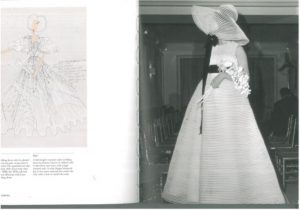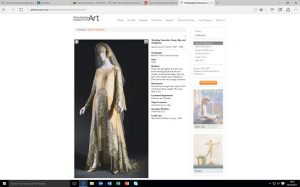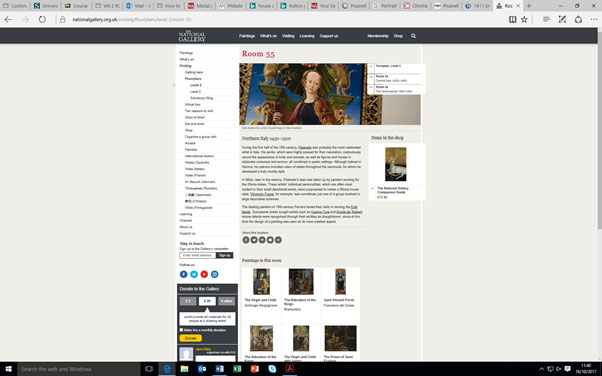
Photograph of a full length romantic-style wedding dress by Jeanne Lanvin in the book ‘The white dress – fashion inspiration for brides by Harriet Worsley’. Page 131 Photographer Hultun

Wedding Ensemble: Dress, Slip, and Headpiece
Jeanne Lanvin, French, 1867 – 1946
http://www.philamuseum.org/collections/permanent/150828.html
I’m interested in wedding dresses and how the symbolism has stayed the same for so many years yet over the years the style of them changes. I also like how each wedding dress is personal to the women wearing it reflecting them individually. I decided to look through books on wedding dresses in the Library. When flicking through the books on Wedding dresses I came across this image of Jeanne Lanvin’s design. I loved everything about the image, how unique the dress was and the pose of the bride. It is unusual to see a bride wearing a hat, not a veil and as a result how the photograph is taken from the side to hide the bride’s face whereas a normal veil would cover the face anyway.
From finding this photo, I was keen to look at other designs by Jeanne Lanvin, I searched her name and came across this other wedding dress that I thought was so unique. On Philadelphia Museum of Art website, they have one of Jeanne Lanvin dresses in their archive. There is a photograph with information written about this dress. They write ‘This wedding ensemble, designed by Lanvin in 1925, evokes the feeling of early fifteenth-century Italian fashion; its silver lamé appliqué and embroidered feather design as well as its rounded bridal headdress recall Pisanello’s well-known studies of Northern Italian women wearing gowns with winged, cape like sleeves and oversized turbans.’
From this I decided to look up Pisanello because he was one of the inspirations for Jeanne Lanvin. Pisanello was believed to have worked in the 15th century as a medallist, fresco and panel painter. There is limited imagery on him because his pieces are so old. He did however create bronze medals that have survived well. Although these do not relate completely to Lanvin’s inspiration, you can still see his use of head dresses in them. The depictions of people on them are all of men not woman but you can still see how he has created exaggerated headpieces for them. I did find this image on the national gallery’s website of one of his works that is painted in Northern Italy estimated around 1430–1500, here you can clearly see how Lanvin’s been inspired. The girl is wearing a headpiece not too dissimilar to the original image from the book I found. Maybe this dress was too inspired by him?

